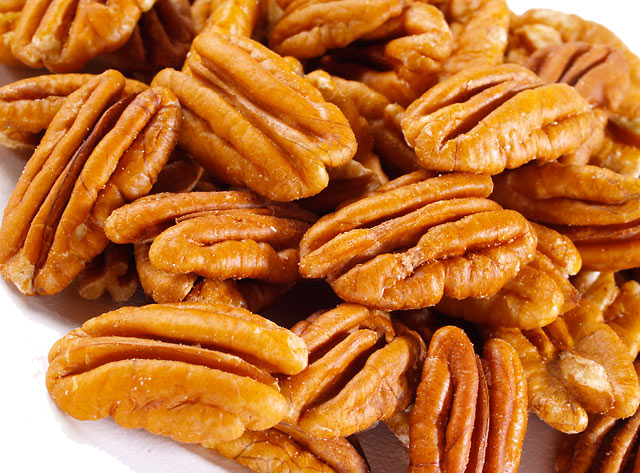
Pecans are so much more than the main ingredient for pecan pie. For one, they are packed with essential nutrients that help protect us against cardiovascular disease (CVD).
Referred to as Carya illinoinensis in scientific literature, pecans are a member of the Juglandaceae family, which makes it a relative of the hickory and the walnut. Pecans are also considered native to North America; their existence has predated even the earliest human settlements.
Despite being referred to as a nut, pecans are actually drupes, a type of fruit where the fleshy part surrounds the pit containing the seeds. Some examples of drupes include cherries, peaches, and plums. However, in the case of pecans, the part consumed is the seed inside the pit and not the fleshy part.
The tree is usually grown in the southern and Midwestern U.S., and it accounts for nearly 80 percent of global pecan production. In particular, the states of Georgia, New Mexico, and Texas produce at least 75 percent of all U.S. pecans, with totals reaching more than 200 million pounds in 2014. Consumption is also high, with pecans being the third most consumed nut in the U.S., behind almonds and English walnuts.
Pecans pack a lot of nutrients, despite their size. They’re known to contain essential fatty acids, at least 17 different vitamins and minerals, and various phenols and phytosterols. They’re also loaded with calories and have one of the highest fat content out of all culinary nuts, after the macadamia. Pecans are also an abundant source of monounsaturated fatty acids (MUFAs), primary oleic acid, and the polyunsaturated fatty acid (PUFA) linoleic acid which is a good source of omega-6. Studies have shown that increasing your MUFA and PUFA intake while lowering saturated and trans fats consumption, is linked to a reduced risk of CVD.
Sponsored: NEW Biostructured Silver First Aid Gel created by the Health Ranger combines three types of silver (ionic silver, colloidal silver, biostructured silver) with seven potent botanicals (rosemary, oregano, cinnamon and more) to create a breakthrough first aid silver gel. Over 50 ppm silver, verified via ICP-MS lab analysis. Made from 100% Texas rain water and 70% solar power. Zero chemical preservatives, fragrances or emulsifiers. See full details here.
The nuts are potent sources of antioxidants, in particular, phenols, condensed tannins, hydrolyzable tannins, and tocopherol isomers which help prevent cell damage due to oxidation. Phenolic acids, especially, have been found to inhibit bacterial growth, as well as prevent cell mutation – a common precursor to cancer. At least 18 different pecan cultivars in the U.S. contain high levels of antioxidants, according to a study.
The shells are also great sources of bioactive compounds, with some reports saying that the levels are higher than that of actual pecan nutmeat. In vivo studies have shown that tea made with pecan nut shells was able to attenuate liver damage, but it has yet to be proven in human models. (Related: Antibiotic era ending – Antimicrobial pecan shell extract can prevent Listeria contamination in organic meats.)
Gamma-tocopherol, an isomer of vitamin E, is abundant in pecans. While other food items have alpha-tocopherol isomers, the derivative from pecans is a stronger antioxidant, according to in vivo tests. It also can clear the body of reactive nitrogen oxide species, which reduces inflammation in the body.
Ideas for a guilt-free pecan pie
Pecan pie is a favorite in most, if not all, American households. However, most recipes call for ridiculous amounts of sugar, or even corn syrup, to give it that delectable sweetness. Here’s one suggestion that replaces sugar with natural ingredients.
What you will need:
- 1 unbaked pie shell (it should be enough for a 12-inch disk)
- 1 cup maple syrup
- 3/4 cup organic cane sugar
- 2 tbsp butter
- 3 large eggs, lightly beaten
- 1 tsp vanilla extract
- 1/4 tsp sea salt
- 1 cup whole pecan halves
How to do it:
- Unwrap your dough and place a new sheet of plastic on top. Roll out the dough in between the plastic sheets until it flattens into a 12-inch disk.
- Remove the top layer of the plastic wrap and place the dough carefully into the pie dish. Once it’s set and flat, peel off the remaining plastic. Fold the overhanging dough on the edge onto itself and crimp it either with your fingers or using a fork. Place it to chill in the refrigerator while you make the filling.
- Preheat the oven to 400 F and adjust rack to the lower-middle position.
- Heat maple syrup over medium heat in a saucepan. Let it simmer until it reaches 225 F.
- While the syrup is simmering, mix the whole cane sugar and the butter in a separate bowl.
- Once the syrup reaches 225 F, immediately pour it into the sugar and butter mixture. Let it sit for a minute, then whisk. Add in eggs, vanilla, and sea salt.
- After combining, pour the mixture into a prepared pie crust and top it with pecans. Bake for 15 minutes, then reduce heat to 350 F and let it finish for at least 25 to 30 minutes more.
- When it comes out of the oven, the filling may be slightly less set in the middle. This will set while the pie is cooling down.
Learn even more benefits of pecans by heading to Food today.
Sources include:
CMS.Herbalgram.org
SeriousEats
DeliciouslyOrganic.net
